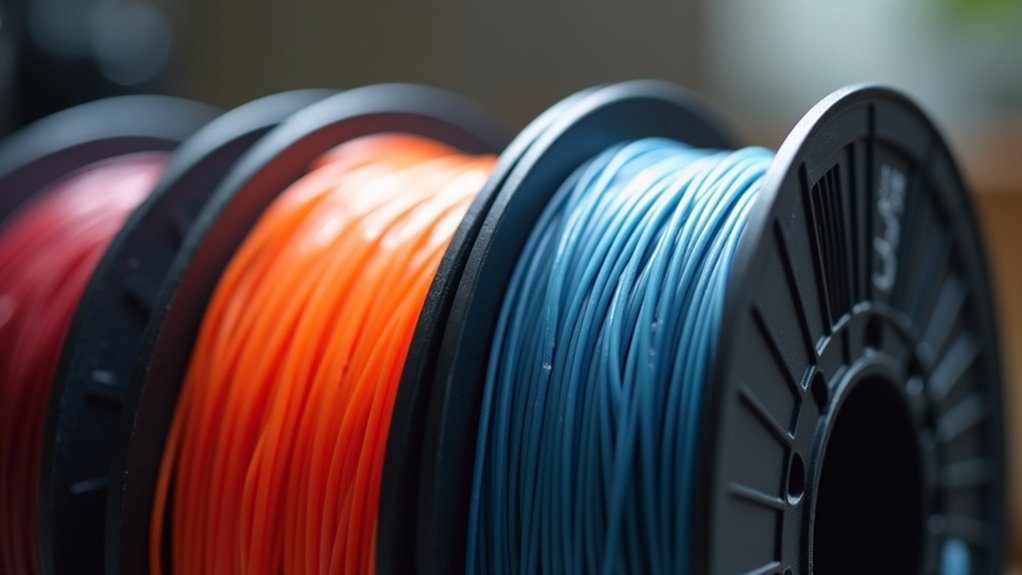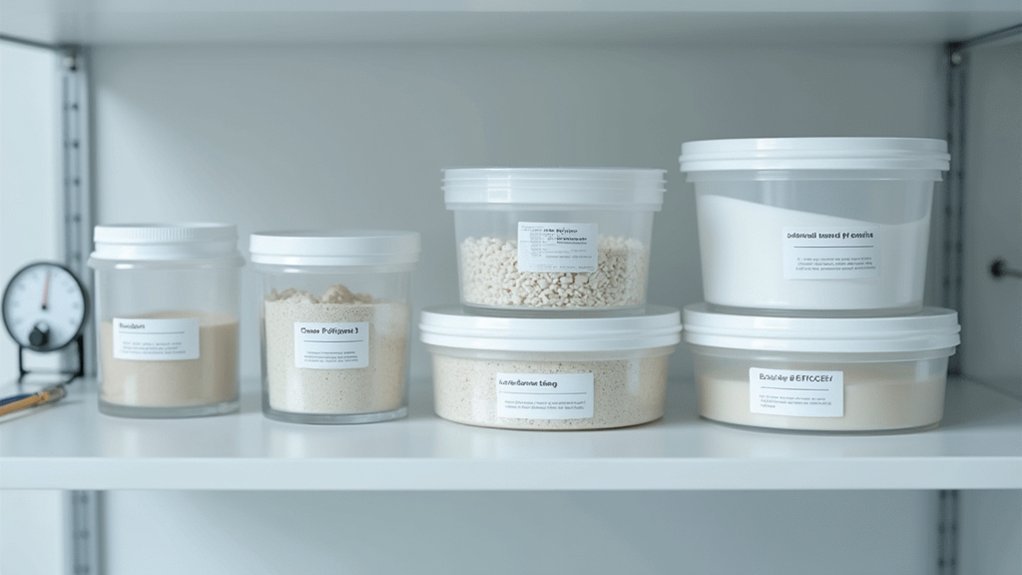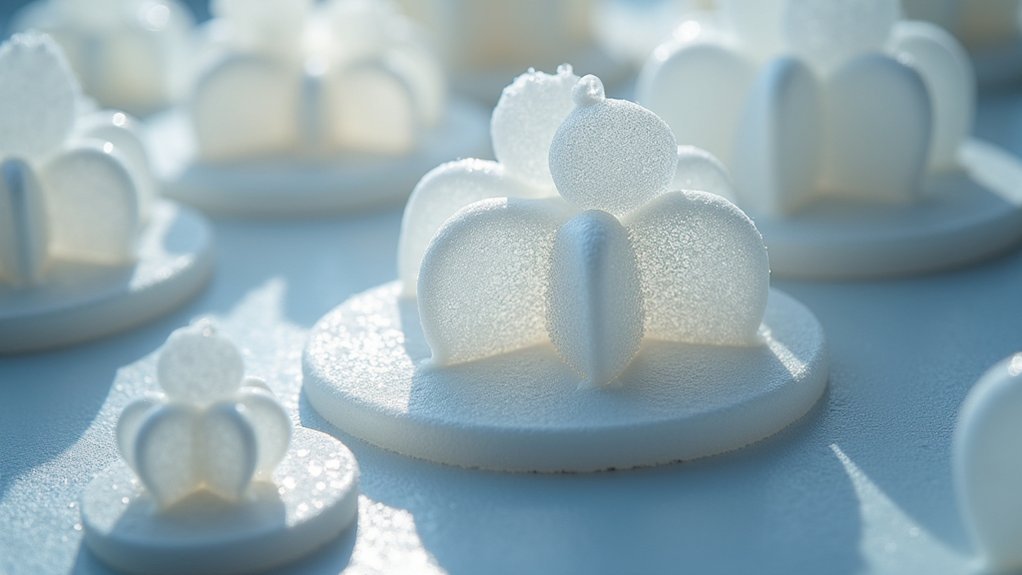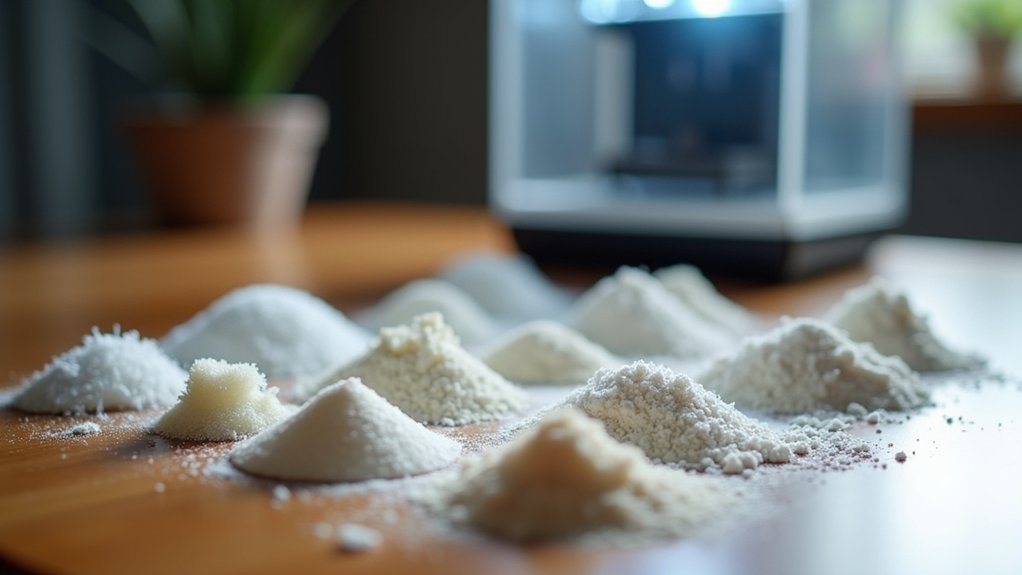You’ll achieve better results with soluble support materials by choosing compatible filament pairings like PVA with PLA, storing materials in dry conditions below 20% humidity, and setting proper temperatures between 180-230°C depending on your material. Configure support density carefully—higher densities provide stability but complicate dissolution—and use grid or triangle patterns at 25 mm/s print speeds to prevent breakage. Plan your model geometry for easy post-processing access, and explore the extensive strategies below for mastering these advanced techniques.
Choose Compatible Materials for Your Primary Filament

When you’re selecting soluble support materials, compatibility with your primary filament becomes the foundation of successful 3D printing. PVA works excellently with PLA, while BVOH offers improved compatibility and faster dissolution times across various materials.
Both soluble materials handle high-temperature filaments like PEEK and PEKK effectively, making them ideal for advanced applications.
Always consult manufacturer documentation for recommended pairings to prevent adhesion issues and print failures. You’ll want to test different combinations since some PVA brands can impact overall print quality.
Don’t rely on generic recommendations—specific brand performance varies greatly.
Stay updated on manufacturer announcements about new compatible materials. Advancements in soluble filaments continuously expand your printing options, giving you access to better support solutions for challenging geometries and diverse primary materials.
Optimize Support Structure Placement and Density
Although soluble supports dissolve completely, you’ll still need to guarantee their placement and density to achieve clean prints and minimize material waste.
Adjust your support density carefully—higher densities provide better stability but complicate dissolution, while lower densities save soluble material but risk print failure.
Use your slicer’s ‘Touching Buildplate’ option for simpler geometries to minimize unnecessary support structures. Choose robust patterns like grid or triangle that resist tearing during printing.
Increase horizontal expansion to thicken supports and improve durability under printing stresses.
Most importantly, optimize the Z distance between supports and your part. Proper gap spacing guarantees easier support removal while maintaining excellent surface quality on your finished print.
Maintain Dry Storage Conditions for Filament Quality

Since water-soluble filaments like PVA and BVOH absorb moisture from the air like sponges, you must store them in completely airtight containers to prevent degradation that’ll ruin your print quality.
These soluble materials demand meticulous moisture absorption prevention to maintain their structural integrity and printing performance.
Invest in a dehumidifying environment like a dry box or dedicated filament storage cabinet. You’ll need to maintain relative humidity below 20% for ideal results.
Regular desiccant replacement in your storage containers creates an additional moisture barrier that protects your investment.
Proper dry storage isn’t optional—it’s essential for preserving filament quality.
Without these precautions, you’ll face poor adhesion, inconsistent extrusion, and failed prints that waste time and materials.
Configure Proper Temperature Settings for Dissolution
Temperature precision determines whether your soluble supports dissolve cleanly or create a frustrating mess that compromises your entire print.
You’ll need to configure proper temperature settings for your specific soluble support material to guarantee ideal dissolution process results.
For PVA or BVOH filaments, stick to manufacturer recommendations. PVA typically requires 180°C to 220°C, while BVOH needs slightly higher temperatures between 190°C to 230°C for effective extrusion.
Don’t guess—regularly calibrate your printer’s temperature settings to maintain consistent flow.
When removing supports, use heated water to expedite dissolution and reduce removal time.
Remember that environmental factors matter too. High humidity can negatively impact dissolution effectiveness and overall print quality, so verify you’re working in suitable conditions for your chosen filament.
Implement Single-Layer Support Interfaces When Possible

When you implement single-layer support interfaces, you’ll dramatically reduce material consumption while achieving superior surface quality on your printed parts. This technique minimizes soluble supports usage, cutting costs and print time considerably.
You’ll notice improved surface finish due to smoother contact areas, making post-print cleanup effortless. Single-layer interfaces prevent clogging issues common with thicker support materials, especially important when using a single extruder setup.
The thinner profile dissolves faster than multi-layer alternatives, streamlining your workflow. You’ll maintain structural integrity during printing while reducing warping and distortion risks.
Configure your slicer to generate minimal support thickness wherever possible. This approach optimizes material efficiency without compromising part quality, delivering professional results with reduced waste and faster processing times.
Adjust Retraction and Purging Settings for Clean Prints
You’ll need to fine-tune your retraction and purging settings to prevent messy shifts when printing with soluble support materials.
Start by increasing your retraction distance and speed beyond standard settings, as materials like PVA and BVOH tend to ooze more during non-print moves.
Configure adequate purge volumes between material switches to guarantee your nozzle’s completely clean before laying down each type of filament.
Optimize Retraction Distance Settings
Since soluble support materials like PVA and BVOH tend to ooze more than standard filaments, you’ll need to dial in your retraction settings for cleaner prints.
Start by adjusting your retraction distance to approximately 1-2 mm specifically for soluble materials like PVA. This setting helps reduce oozing and stringing that commonly occurs with these hygroscopic filaments.
Don’t rely solely on retraction distance adjustments. You’ll also want to enhance your printing speed to work harmoniously with your retraction settings.
The key is finding the balance between effective material pullback and maintaining consistent flow when printing resumes. Test different retraction distance values within the 1-2 mm range while monitoring your print quality, as the best setting may vary depending on your specific printer setup and environmental conditions.
Configure Purge Volume Parameters
Although retraction distance is crucial for controlling ooze, proper purge volume configuration guarantees your nozzle delivers clean material shifts throughout your print. When using soluble supports, you’ll need increased purge volume to completely clear residual material before each material change. This prevents contamination between your primary filament and support material.
| Parameter | Standard Setting | Soluble Support Setting | Notes |
|---|---|---|---|
| Purge Volume | 50-100 mm³ | 150-250 mm³ | Increased for thorough clearing |
| Prime Tower | Optional | Recommended | Maintains consistent flow |
| Purging Temperature | Standard temp | +5-10°C higher | Assures smooth extrusion |
| Change Speed | 25 mm/s | 20-30 mm/s | Controlled material shift |
| Nozzle Cleaning | Weekly | Per print session | Prevents buildup issues |
Regular nozzle cleaning maintains ideal purging performance throughout multi-material printing sessions.
Minimize Oozing Between Materials
Optimized purge volumes work hand-in-hand with precise retraction settings to eliminate unwanted material oozing between your primary filament and soluble supports.
You’ll want to adjust your retraction distance between 2-5 mm when working with soluble materials like PVA+ support interface filaments. Set retraction speeds at 30-60 mm/s to quickly pull back material during dual extruder shifts, effectively reducing ooze buildup.
Configure your slicer to include purge lines or prime towers, ensuring each extruder’s properly primed before printing begins. This prevents contamination between materials and maintains clean layer interfaces.
Use cooling fans during filament changes to solidify material faster and minimize oozing, especially with slower-cooling soluble materials. Regular nozzle cleaning prevents clogs that worsen oozing issues, keeping your dual-material prints pristine.
Use Grid and Triangle Patterns for Stronger Support Towers
When you’re dealing with tall or complex overhangs, the pattern you choose for your support structures can make the difference between a successful print and a failed one.
Grid and triangle patterns offer superior strength compared to standard linear supports, especially when working with soluble support materials that need to maintain structural integrity throughout the printing process.
Here’s how to enhance your support tower strength:
- Choose grid patterns for balanced load distribution that prevents tearing during printing
- Use triangle patterns for enhanced stability and deformation resistance under stress
- Increase horizontal expansion to thicken support structures and improve breakage resistance
- Reduce support printing speed to prevent fragile structures from failing mid-print
- Combine grid and triangle patterns for maximum strength while maintaining easy removal and quality surface finishes on printed parts
Set Appropriate Print Speeds to Prevent Support Breakage
While strong support patterns provide the foundation for reliable soluble supports, print speed settings determine whether those structures will survive the printing process intact. You’ll need to set your printing speed for support materials to approximately 25 mm/s to prevent breakage during printing. This slower pace reduces oozing issues and improves layer adhesion between support structures.
| Setting | Recommended Speed | Purpose |
|---|---|---|
| Support materials | 25 mm/s | Prevent breakage |
| Interface layers | 20 mm/s | Maintain stability |
| First layer | 15 mm/s | Guarantee adhesion |
| Infill supports | 25 mm/s | Structural integrity |
| Perimeter supports | 20 mm/s | Surface quality |
Adjust your interface printing speed to 80% of support speed for best results. Monitor how different soluble filaments behave and modify settings accordingly, as each material responds differently to speed changes affecting your printed parts’ quality.
Plan for Efficient Post-Processing and Material Removal
Although proper print settings guarantee your supports survive the printing process, efficient post-processing requires strategic planning before you even start your print job.
Consider your model’s geometry and plan access routes for removing water-soluble materials from intricate areas.
Strategic model design requires pre-planning dissolution pathways to ensure complete water-soluble support removal from complex geometric features.
- Design with removal in mind – Plan small parts and cavities to allow easy access when you remove the support material
- Follow manufacturer guidelines – Different soluble interface materials require specific dissolution times and techniques for best results
- Heat your dissolution water – Warmer water accelerates the post processing timeline considerably
- Manually detach loose supports first – Carefully remove accessible supports before dissolving to prevent model damage
- Dispose responsibly – Follow local recycling regulations when handling support material waste
Leverage Community Knowledge for Troubleshooting Solutions
When you’re struggling with soluble support issues, community forums offer a goldmine of real-world solutions from experienced users who’ve faced similar challenges.
You’ll find shared printer settings and configurations that have proven successful with specific filament brands and printer combinations, saving you hours of trial-and-error testing.
These collaborative spaces let you tap into collective troubleshooting wisdom while contributing your own discoveries to help others overcome common soluble material failures.
Community Forum Solutions
Since community forums represent a treasure trove of real-world experience with soluble support materials, you’ll find invaluable troubleshooting solutions from users who’ve already tackled the challenges you’re facing.
These platforms offer practical tips and tricks that can save you countless hours of printing time and wasted filament. Members share their customized settings and configurations, helping you optimize your soluble support printing process.
- Download proven slicer profiles and temperature settings from experienced users
- Access troubleshooting guides for idler tension and retraction adjustments
- Learn proper storage techniques using dry boxes to prevent moisture absorption
- Compare different soluble filament brands through user reviews and performance reports
- Master purging strategies for multi-material prints to reduce contamination risks
Shared Settings Configurations
While experimenting with different settings can consume weeks of trial and error, community-shared configurations offer you a direct path to proven solutions that eliminate guesswork from your soluble support printing workflow.
You’ll find tremendous value in adopting proven configurations like setting your support material interface speed to 80% of your main printing speed. This adjustment greatly improves print quality while maintaining reliable adhesion.
Configure your interface extruder pattern spacing to 0.1 mm for enhanced dissolution, making post-processing much easier.
Synchronize your support layers with object layers and set Top Z contact distance to 0 for ideal wipe tower functionality.
Create custom filament profiles addressing compatibility issues with specific soluble materials like PVA and BVOH. These community-tested configurations save you countless hours while delivering consistently superior results.
Frequently Asked Questions
What Is the Best Temperature for PVA?
You’ll get ideal PVA printing results with nozzle temperatures between 180°C and 220°C, though you should use at least 210°C for support material applications to guarantee proper layer adhesion and dissolvability.
How to Dissolve PLA Supports?
You can’t dissolve PLA supports with water since PLA isn’t water-soluble. You’ll need to use water-soluble support materials like PVA or BVOH instead, then submerge in warm water.
What Is the 45 Degree Rule for 3D Printing?
You’ll need support structures when your overhangs exceed 45 degrees from vertical. This rule prevents sagging and print failures since filament can’t bridge gaps effectively beyond this angle without additional support.
What Is the Strongest Support Pattern for 3D Printing?
You’ll find grid and triangle patterns are the strongest support options for 3D printing. They’ll provide superior tear resistance and stability compared to other patterns, ensuring your overhangs print successfully.





Leave a Reply